.
The Manned Anti-Satellite System
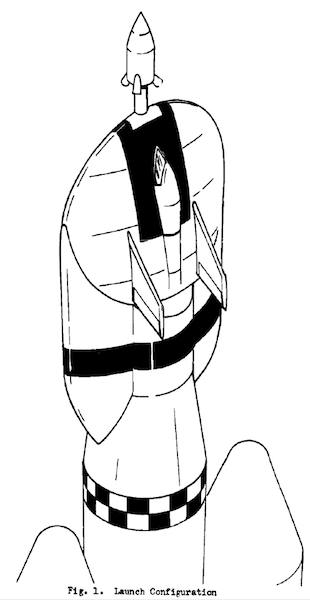
The USAF had the SAINT (Satellite Inspector for Space Defense) anti-satellite system under study since June 1958 and had awarded the development contract to RCA for a three-phase Saint I unmanned program covering the Green Saint and White Saint inspection and satellite destruction spacecraft. Studies were also underway on Blue Saint, a Saint II follow-on manned vehicle.
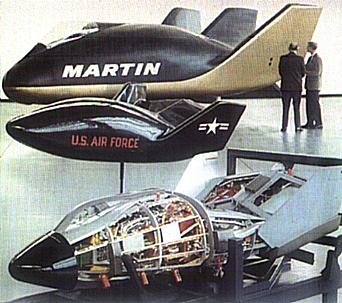
Blue Saint was seen as competing with the well-advanced Boeing X-20 Dynasoar manned glider program, and in October 1961 it was criticized by a USAF panel for over-optimistic schedule and budget. All of this was heavily classified. It is not known if there was a competitive bidding for Blue Saint, or if Convair submitted a proposal. It seems that Martin Aircraft was the winner, as it was connected with the related public experimental SV-5, X-23, and X-24 lifting body spacecraft in the early 1960's. Another player was McDonnell Aircraft, who was beginning work leading to the Isinglass reconnaissance spacecraft in 1965.
Against this turbulent background Earl Honeywell suddenly emerged in public at the Eighth Symposium on Ballistic Missile and Space Technology in San Diego on 17 October 1963 to describe in considerable detail Convair's ultimate derivative of Pye Wacket, the Manned Anti-Satellite System. This looks like it may have been Convair's losing proposal for Saint II. Making it public was rather remarkable given the deep black nature of Saint. However McNamara had essentially cancelled Saint in October 1962 and it is possible that there was no longer any prohibition in discussing it. Or it may have been deliberate misinformation, to hide the fact that behind the cancellation of Saint was a move to the deeper-black air-launched Isinglass program. For whatever reason, Honeywell was careful to note that his paper "...was the result of General Dynamics/ Pomona-funded research and in no way can be construed as having the endorsement of the Department of Defense or the U.S. Air Force". That research had begun during Pye Wacket Phase II, with the first report issued in March 1961, only a month after the FTV report.
The Manned Vehicle (MV) was designed for launch by the same man-rated Titan III launch vehicle in development for the Dyna Soar. The approach was that the MV would stand off at a safe fifty-mile distance from the target satellite while a small Interspector/Killer (I/K) device would rendezvous with the target, examine it up close, then destroy it on command if needed. This approach allowed the MV and the I/K devices to have very large delta-V capabilities (7000 feet/second for the MV and 9600 ft/sec for the I/K). This would allow a quick response. Any satellite could be intercepted within 100 minutes with launch at almost any time. Alternatively multiple satellites in varying orbits could be intercepted on a single mission. This was in contrast to coplanar schemes like Saint I or the Soviet IS-A ASAT, which had to be launched into the orbital plane of the target. Their limited maneuverability meant tight once- or twice-daily launch windows. The scheme also allowed the crew to remain at a safe distance from the hostile satellite. Soviet military satellites were in fact equipped with self-destruct charges, although it is not known if US intelligence was aware of this.
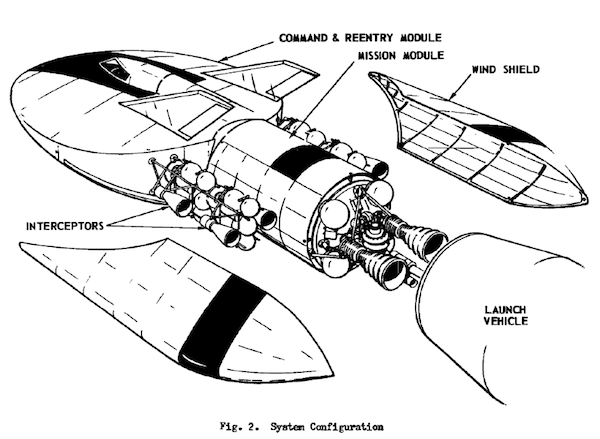
The MV in orbit had two modules. Weight breakdown was as follows:
Command Module (CM): 8,500 lbMission Module (MM): 20,500 lb consisting of:
Four Inspector/Killer Devices (I/K): 1,680 lb
Engine: 3,600 lb
Propellant: 14,300 lb
Control, Radar, Misc.: 920 lbTotal: 29,000 lb
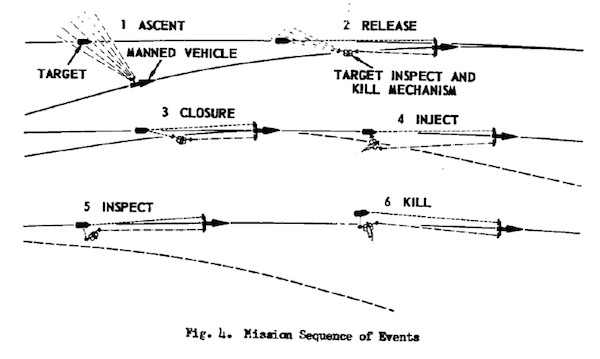
The baseline mission involved a minimum energy scenario. During Phase 1 the MV ascended to the target satellite orbit and the radar was in search mode. In Phase 2 the MV radar acquired the target while the MV neared apogee 50 miles ahead of the target. At this time an I/K Device would be released and allowed to coast freely along the ascent trajectory. In Phase 3 the manned vehicle reached apogee and injected into the target orbit. The inspector meanwhile was in the slower transfer trajectory. Inspection was initiated when the target came within range and the inspector made an orbit plane correction if required. In Phase 4 the target caught up with the inspector which then injected into the target orbit. In Phase 5 the inspector maneuvered around the target to perform close inspection. In Phase 6, if the target was determined to be hostile, the target would be destroyed. Phase 6 could also be implemented at any time after the I/K was released from the manned vehicle.
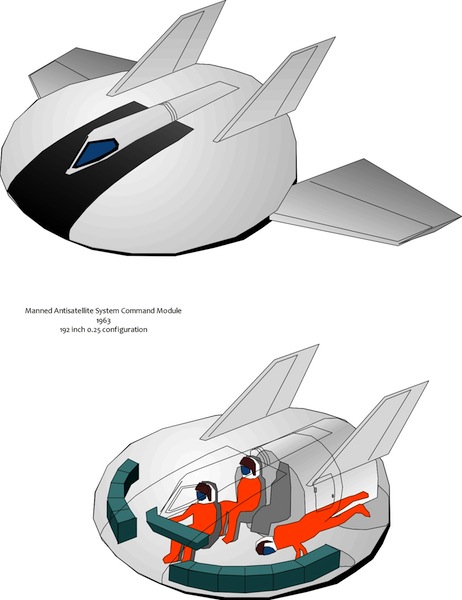
The CM was a lenticular reentry vehicle with a crew of three based on Pye Wacket work. The this was the only module of the system that returned to earth. The cockpit section could be separated from the command module at subsonic speeds for abort on the launch pad, during the initial phases of ascent, or in case of difficulties in landing.
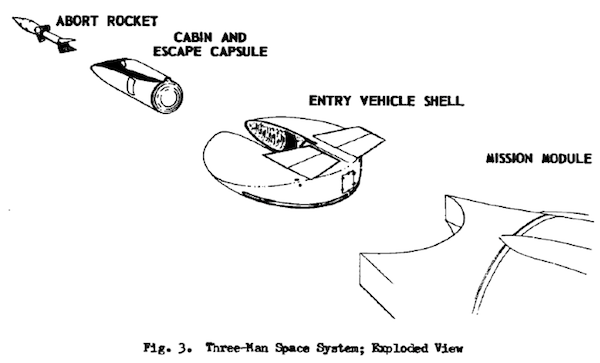
The CM would reenter at a 60 to 75 deg angle of attack, presenting a thin blunt surface which was optimum for deceleration at higher altitudes. Trajectory control woud be by rolling while still maintaining the high angle of attack. The lenticular vehicle minimized heat shield requirements while providing a high hypersonic L/D ratio, maximizing cross range capability. Once the saucer slowed down to transonic speed, horizontal stabilizers were deployed.
The 16-foot-diameter CM would have been rather cramped. The thickness of the saucer is not indicated, but even with the cockpit section above the top of the saucer, the cockpit could not have had a height much greater than five feet and the saucer thickness had to be greater than the 21% maximum considered for Pye Wacket. How the deployable wings, and landing gear or skids were housed is not clear. One crew member at a time could work their way from the cockpit module through a small hatch into a claustrophobic pressurized cabin which at least allowed them to stand up while working. The 8500 pound estimated mass of the densely-packed vehicle seems optimistic compared to the 13,000 pounds of the Apollo command module.
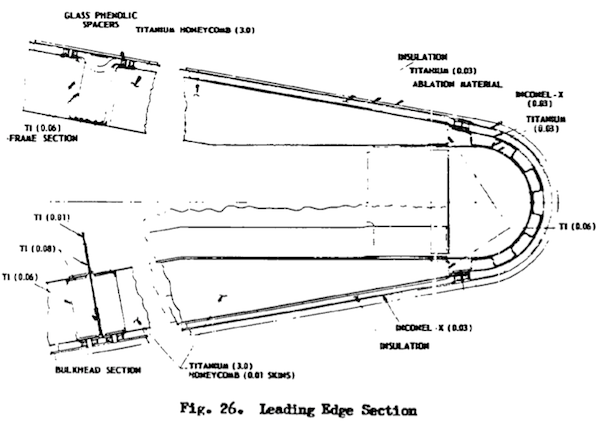
The CM used a double-wall structure. The inner wall of deep-cored honeycomb sandwich panels was the load-bearing structure. The outer wall heat shield consisted of segmented laminate panels of ablative material, radiative metal skin, and insulation material. To handle thermal expansion during reentry the overlapping panels were attached to the inner wall with flexible thermally insulated clips.
The MM Mission Module consisted of four satellite inspector/killer mechanisms the fire control radar, and the propulsion system for orbital maneuvers. This propulsion system is not described in detail, but appears to be a smaller-diameter version of the Titan Transtage with about half the propellant load.
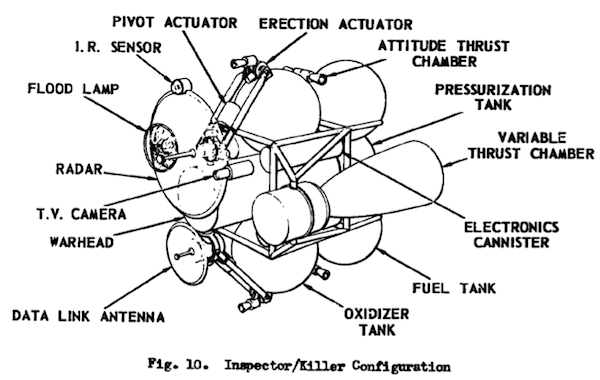
The I/K devices had two main engines of 1600 lbs thrust each and six separate attitude control engines of 5 lbs thrust each. Aside from the propellant and pressurization tanks, the device carried a data link antenna, target tracking radar antenna, TV camera, IR sensor, warhead, and a flood lamp for inspection while in the earth's shadow. The radar and data link antenna were folded for minimum storage volume in the mission module. The I/K device fit in a volume of 47 in. by 38 in. by 38 in. when packaged in the launch configuration.
The I/K's two gyro-stabilized antennas tracked the target and the MV simultaneously. The guidance system used these two positions to keep the device oriented horizontally between the MV and the target.
Optical inspection of the target would be accomplished by the MV using telescopes. In the earth's shadow the I/K device would illuminate the target. Any necessary detailed assessment would be made by a fly-around of the target by the I/K using television, infrared, and radiation sensors. Commands to the I/K and data from it would be relayed via a PCM/FM data link.
The I/K semi-active seeker was a pulse receiver compatible with the fire control radar on the manned vehicle. A home-on-jam mode was also be provided. If the target took evasive maneuvers, the I/K would fly a modified proportional navigation course to intercept. The I/K's shaped charge fragmenting warhead had a theoretical kill probability of 95.3% for a 2-square-foot target with an aiming error of 10 ft.
The I/K propellant was nitrogen tetroxide / 50% hydrazine - 50% unsymmetrical dimethyel hydrazine. The 3200 lb thrust provided a 12 G acceleration. Packaging requirements required the use of two chambers with a 30:1 nozzle area ratio and two sets of propellant tanks. Total weight of each I/K was 473 pounds, of which 290 lbs was propellant. Electronics, the communication link, and inspection system took up 48 pounds, the warhead 38 pounds, the dry mass of the propulsion system 96 pounds, with only 8 pounds for the light-weight structure.
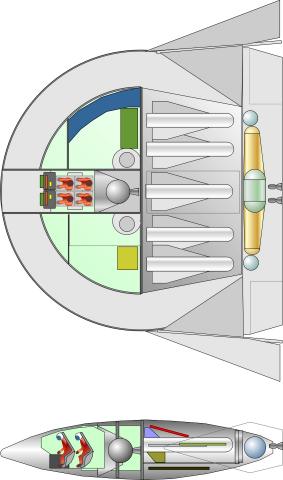
The highest priority target would be an enemy orbital bomber. This was not a fantasy; such spacecraft were under study and development in both countries. This would require sensors for nuclear bomb detection; target mass determination; multispectral electromagnetic radiation detection. A decoy exterminator function would be necessary in case an orbital bomber went into action. None of these capabilities was included in the initial design, but could be developed in the future.
In one scenario ferret equipment could be fitted on the I/K to allow it to monitor enemy communications. It would loiter near the target and proceed with destruction only when the target received an order from the ground to initiate hostile operations. It was also possible that some "clever device" could be installed on the I/K to reveal and destroy decoys without requiring the firing of the warhead.
After Pye Wacket
After the 17 May 1963 appearance Earl Honeywell disappears completely from the documentary record. No further papers have been declassified to date that appear with his name or that of the elusive D R Geise. Public records show that he continued to live in the Pomona area, probably continuing to work for General Dynamics. His wife passed away on 7 October 1969, and he remarried on 5 February 1971. Sometime before 1993 he returned to the Seattle, Washington area. He died there on 9 October 1998 and was buried at Tahoma National Cemetery. On the other hand Hatalsky and Velton had well-documented careers and continued at General Dynamics Pomona until retirement.
Did Earl Honeywell continue his work on deep black programs? Or was Pye Wacket the young engineer's biggest project? Was he, like Orson Welles, someone who lived his life in reverse, with the biggest accomplishment being followed by decades of mundane work?
Active air-to-air bomber defenses never were never developed further. Radar evasion, stealth, decoys, air-to-surface missiles, and electronic countermeasures were used instead.
On the other hand it is known is that the Air Force continued to pursue manned spaceflight on behalf of the CIA. By 1964 there were competing designs for an air-launched manned reconnaissance spacecraft by General Dynamics Fort Worth and McDonnell Saint Louis. It is possible Earl Honeywell was involved with the Convair project. However the nod seems to have gone to McDonnell, who pursued development of Isinglass until 1968. Officially, neither of these concepts were found to have advantages in comparison to satellites to justify the high development and operating risk and costs.
Then in March 2006 Aviation Week and Space Technology made the astounding claim that the United States had developed a reusable two-stage-two-orbit manned spacecraft in the 1990's, dubbed Blackstar, and flown it on numerous orbital and suborbital missions. Development began after the Challenger shuttle disaster in 1986 and the Blackstar was only retired in 2005. If this system actually existed and was flown, the history of manned spaceflight would have to be revised.
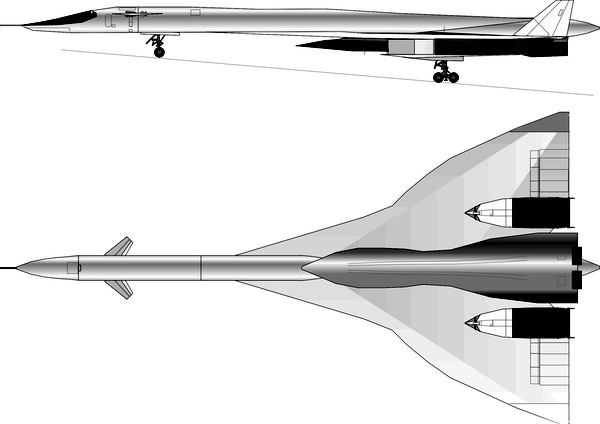
The first stage of the Blackstar system was said to be a Mach 3+ winged air-breathing first stage evidently developed from North American's XB-70 bomber. The second stage was the XOV manned eXperimental Orbital Vehicle lifting body. The system was developed by a "consortium of US aerospace companies" at the behest of an "unspecified US government agency". The system was so classified that it remained unknown to the nation's top military and civilian space planners, while they labored to design, but never developed, an equivalent white-world system. Blackstar was designed to handle numerous missions: strategic reconnaissance; anti-satellite; quick-reaction small satellite launch; and delivery of small conventional warheads.
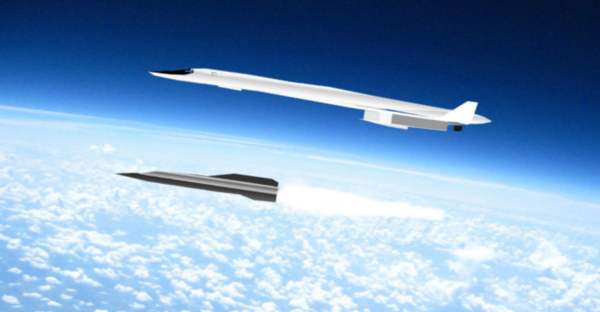
Did Blackstar exist? Did Earl Honeywell and the mysterious D R Geise have black-world careers building Pye Wacket derivatives? We may never know.
References and Chronology
1958: Experimental and Theoretical Investigations on Lenticular Rocket Shapes (U) Technical Planning Group, Directorate of Development, Air Proving Ground Center, Eglin Air Force Base, Florida (SECRET) Leading edge deflection was proposed by the Air Proving Ground Center and was investigated in this APGC "in house" test program.26 November 1958: R&D EXHIBIT NO. PGEM 58-162 Research Requirements ofr Lenticular Rocket, Technical Planning Group, Directorate of Development, Air Proving Ground Center, Eglin Air Force Base, Florida.
23 March 1959: RFP to Industry
April 1959: CPC-1393 Proposal for Lenticular Rocket Feasibility Study, presented to Air Proving Ground Center, United States Air Force by Convair- Pomona, April 1959.
June 1959: ARDC Project 3811 Contract: AF 08(635)-542 six month study Phase I
23 June 1959: Honeywell, E. E., TM-334-337, "Compilation of Power-Off Base Drag Data and Empirical Methods for Predicting Power-Off Base Drag, Convair-Pomona, 23 June 1959.
Honeywell, E. E., Giese, D. J., TM-334-375 Pye Wacket Wind Tunnel Test No. I Pre-Test Report, " by E. E. Honeywell and D. J. Giese, Convair-Pomona July 1959.
Honeywell, E. E., Giese, D. J., TM-334-385 and TM-334-3S5A, "Pye Wacket Wind Tunnel Test No. II Pre-Test Report, , Convair-Pomona, September 1959.
September 1959: Velton, E. J. and Hatalsky, W., IC-334-231 Visit to Convair Scientific Research Division, Convair, A Division of General Dynamics, Pomona, California, September 1959.
October 1959: Velton, E. J. and Hatalsky, W., IC-334-248 "Trip Report on Consultation with Dr. A. J. Eggers at Ames Laboratory, Moffet Field, California, Convair, A Division of General Dynamics, Pomona, California, October 1959.
November 1959: Honeywell, E. E., Giese, D. J. , TM-334-409 Preliminary Results of Pye Wacket Wind Tunnel Tests, Convair Pomona, November 1959
December 1959: TM349-15 Preliminary Investigation of Aerodynamic Heating Effects on an Infrared Window, Convair-Pomona, December 1959.
14 January 1960: Pye Wacket Lenticular Rocket Feasibility Study, Convair Division of General Dynamics Corporation for the Air Proving Ground, Air Research and Development Command United States Air Force, Eglin Air Force Base, Florida, 14 January 1960. ARDC Project 3811 Contract: AF 08(635)-542
March 1960: Infrared Study Summary and Conclusions, Volume V-A, Crosley Report No. 6654-58-ll(V-A), Contract No. AF 33 (616)-5311. Crosley contract for guidance and control.
May 1960: DD613 North American Aviation Defense Study, ; Project 5155, May 1960. Documented evaluation of passive and active defense systems for B-70.
May 1960: Pye Wacket Lenticular Rocket Feasibility Study AFSC- TF-60-25, May 1960, Secret. Published version of February Feasibility Study.
July 1960: Giese, D. J., TM 334-450 Pye Wacket Wind Tunnel Test No. III- PWT Pre-Test Report, Convair-Pomona, July 1960.
July 1960: Giese, D. J., TM-334-454, Pye Wacket Wind Tunnel Test No. IV, Pre-Test Report, Type A Wind Tunnel, Convair-Pomona, July 1960.
July 1960: Jones, R. D., and Featherstone, H. A., TM-334-451, "Estimated Omnidirectional Launch Aerodynamic for-PY WACKET FTV Configuration, Convair-Pomona, July 1960.
12-23 September 1960: Tests of a 1/3-scale Pye Wacket missile conducted in the PWT 16-Foot Transonic Circuit for the Convair Division of General Dynamics Corporation.
December 1960: Baker, D. C. and Galigher, L. L., INVESTIGATION OF STATIC STABILITY AND AERODYNAMIC EFFECTS OF CONTROL JETS ON A 1/3-SCALE Pye Wacket MISSILE AT TRANSONIC MACH NUMBERS, PWT, ARO, Inc., December 1960.
22 December 1960: Convair/Pomona Letter No. II-8837/2217 dated 22 December 1960 to Directorate of Procurement, Eglin AFB, Florida Phase III of the Feasibility Studies Proposal - involved fabrication of a number of flight vehicles and flight test of these missiles from a high speed sled (12 vehicles proposed).
15 February 1961: Pye Wacket Feasibility Test Vehicle Study, General Dynamics Pomona, California, for Detachment 4, Headquarters, Air Force Systems Command, Eglin Air Force Base, Florida, 15 February 1961. AFSC Project 3811 Contract AF 08(635)-1168.
March 1961: Honeywell, E. E., TM-341-147:,Manned Re-entry Vehicle Preliminary Design Study, General Dynamics/Pomona, March 1961.
October 1961: DEVELOPMENT OF AIRBORNE ARMAMENT 1910-1961; VOLUME II BOMBER DEFENSE, AFSC HISTORICAL PUBLICATIONS SERIES 61-52-(2) , Air Force Systems Command, October 1961. Discuses Lenticular Defense Missile for B-70 in 1959.
October 1962: Honeywell, E. E., ERR-PO-086 Preliminary Design of a Three Man Orbital and Re-entry Vehicle, General Dynamics/Pomona, October 1962
January 1963: Honeywell, E E, Satellite Inspector/Killer Mechanism Study, General Dynamics/Pomona, TM-341-177, January 1963.
17 October 1963, "Anti-Satellite System Proposed", The San Mateo Times
16-18 October 1963: Honeywell, E. E., "MANNED ANTI-SATELLITE SYSTEM", General Dynamics Corporation, Pomona Division, Pomona, California, in TRANSACTIONS OF THE EIGHTH SYMPOSIUM ON BALLISTIC MISSILE AND SPACE TECHNOLOGY, VOLUME II, Held at the United States Naval Training Center San Diego, California on 16-18 October 1963
Also consulted:
McPhee, John, The Curve of Binding Energy: A Journey into the Awesome and Alarming World of Theodore B. Taylor, Farrar, Straus and Giroux,1994
Dyson, George, Project Orion - The True Story of the Atomic Spaceship, Henry Holt and Company, 2002.
Jenkins, Dennis R and Landis, Tony R, Valkyrie: North American's Mach 3 Superbomber, Specialty Press, 2004
Scott, William B, "Two-Stage-to-Orbit 'Blackstar' System Shelved at Groom Lake?", Aviation Week and Space Techonology, 6 March 2006
Quelle: Encyclopedia Astronautica
